Photo

Vintage Nasa Photograph, Red serial Number
20.1 cm x 25.3 cm, Vintage Chromogenic Print on Kodak Paper
10 June 1973
JOHNSON SPACE CENTER, HOUSTON, TEXAS
NASA S-74-15561
SKYLAB 2 AT.1 PICTURE -------
The solar eruption of June 10, 1973 is seen in this spectroheliogram obtained during the first manned Skylab mission (Skylab 2) with the S082A expriment, an Apollo Telescope Mount component covering the wavelength region from 150 to 650 anstroms (extreme ultraviolet). The solide disk in the center was produced from 304 anstrom ultraviolet light from He + ions. At the top of the image a great eruption is visible extending more than one-third of a solar radius from the Sun’s surface. This eruption preceded the formation of an enormous coronal bubble winch extended a distance of several radio form the Sun’s surface, and which was observer with the coronographe aboard the Skylab space station in Earth orbit. In contrats, the Fa XV image at 285 anstroms just to the right of the 304 anstroms image does not show this event. Instead, it shows the bright emission from a magnetic region in the lower corona. In this picture, solar north is to the right , and east is up. The wavelength scale increases to the left. The U.S. Naval Research Laboratory is principal investigation of the S082 expriment.
#VintageNasaPhotograph#Vintagenasaphotographs#vintage#Nasa#Photo#NasaPhoto#Vintagenasaphoto#chromogenicprint#Redserialnumber#Kodak Paper#Red Serial Number#Nasa Red Serial Number#Sun#Solar eruption#angstroms#Solar#Telescope#Ultraviolet#Skylab#Skylab 2#S082 Experiment#Experiment#Earth Orbit#US Naval Research Laboratory#Ultraviolet Light#anstrom
2 notes
·
View notes
Photo

Vintage Nasa Photo
20.2 x 25.4 cm, Vintage Chromogenic Print on Kodak Paper
108-KSC-77PC-419 UNCL. 7/18/77
NASA/SHUTTLE W/O F911-083
DM-1 DURING STATIC TEST. (br)
#Vintagenasaphotographs#vintagenasaphotograph#vintage#photo#ChromogenicPrint#NASAphoto#NASA#Beauty#Collection#ARTCOLLECTOR#SHUTTLE#TEST#EXPLOSION#Kodak#Kodakpaper#Original#OriginalNasaPhoto
1 note
·
View note
Photo
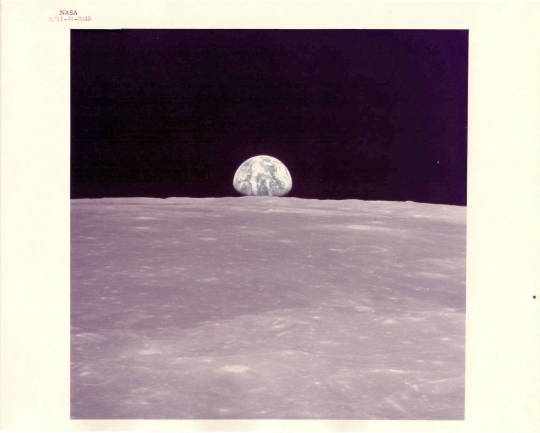
Nasa Vintage Photograph
25.4 cm x 20.1 cm, Vintage Chromogenic Print on Kodak Paper
NASA AS11-44-6549
AS11-44-6549 (16-24 July 1969) ---
This view from the Apollo 11 spacecraft shows Earth rising above the moon's horizon. The lunar terrain pictured is in the area of Smyth's Sea on the nearside. Coordinates of the center of the terrain are 86 degrees east longitude and 3 degrees north latitude. While astronauts Neil A. Armstrong, commander, and Edwin E. Aldrin Jr., lunar module pilot, descended in the Lunar Module (LM) "Eagle" to explore the Sea of Tranquility region of the moon, astronaut Michael Collins, command module pilot, remained with the Command and Service Modules (CSM) "Columbia" in lunar orbit.
#NASA#nasavintagephotograph#Apollo#Apollo 11#spacecraft#Earth#Earth rising#moon#lunar#Smith's Sea#Neil Armstrong#Aldrin#Astronaut#Lunar Module#Eagle#Chromogenic Print#Kodak Paper#Kodak#Vintage#Photo#Sea of Tranquility#Collins#CSM#Columbia#lunar orbit
2 notes
·
View notes
Photo
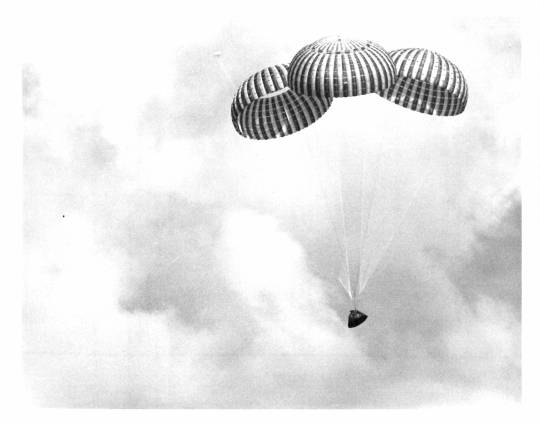
Vintage Nasa Photograph
25.4 cm x 20.1 cm, Vintage Gelatin Silver Print
Nasa Serial Number: 108-KSC-71P-150 71-H-311
APOLLO 14 PACIFIC RECOVERY AREA - - -
The Apollo 14 spacecraft parachutes to a precise and safe splashdown into the Pacific Ocean, approximately 780 nautical miles southeast of American Samoa. The spacecraft touched down at 4:05 p.m. EST Feb. 9, 1971, nine days after Astronauts Alan B. Shepard, Jr., Stuart A. Roosa and Edgar D. Mitchell were launched on the Nation’s third mande lunar landing mission. The National Aeronautics and Space Administration directs the Apollo program.
#Nasa#VintageNasaPhotograph#Vintage gelatin silver print#Apollo#Apollo 14#spacecraft#parachute#splashdown#1971#Astronaut#Alan B. Shepard#Mitchell#Roosa#Black and white#vintage#Photo#Black and white photo#lunar mission#Nasa Vintage Photo#Samoa#Pacific Ocean
0 notes
Photo
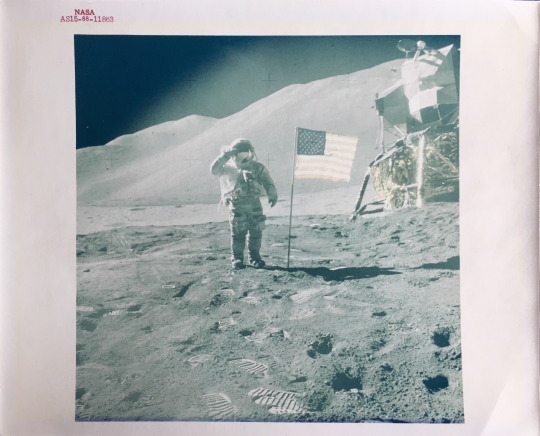
Vintage Nasa Photograph
25.4 cm x 20.1 cm, Vintage Chromogenic Print on Kodak Paper
Red Serial Number
AS15-88-11863 (1 Aug. 1971) ---
Astronaut David R. Scott, commander, gives a military salute while standing beside the deployed United States flag during the Apollo 15 lunar surface extravehicular activity (EVA) at the Hadley-Apennine landing site. The flag was deployed toward the end of EVA-2. The Lunar Module (LM), "Falcon," is partially visible on the right. Hadley Delta in the background rises approximately 4,000 meters (about 13,124 feet) above the plain. The base of the mountain is approximately 5 kilometers (about three statue miles) away. This photograph was taken by astronaut James B. Irwin, lunar module pilot. While astronauts Scott and Irwin descended in the LM to explore the moon, astronaut Alfred M. Worden, command module pilot, remained in lunar orbit in the Command and Service Modules (CSM).
#Moon#Apollo 15#Apollo#Vintagenasaphotograph#NASA#Astronaut#David R. Scott#EVA#Lunar Module#America#American Flag#Salute#Military Salute
2 notes
·
View notes
Photo

Vintage Nasa Photograph
25.4 cm x 20.1 cm, Vintage Chromogenic Print on Kodak Paper
Red Serial NASA
S72-35347 (16 April 1972) ---
The huge, 363-feet tall Apollo 16 (Spacecraft 113/Lunar Module 11/ Saturn 511) space vehicle is launched from Pad A, Launch Complex 39, Kennedy Space Center (KSC), Florida, at 12:54:00.569 p.m. (EST), April 16, 1972, on a lunar landing mission. Aboard the Apollo 16 spacecraft were astronauts John W. Young, commander; Thomas K. Mattingly II, command module pilot; and Charles M. Duke Jr., lunar module pilot. While astronauts Young and Duke descended in the Lunar Module (LM) "Orion" to explore the Descartes highlands region of the moon, astronaut Mattingly remained with the Command and Service Modules (CSM) "Casper" in lunar orbit.
#Vintage#Vintagenasaphotograph#Apollo#Apollo 16#Launch#Saturn#Lift Off#Space#Moon#Astronaut#History#Kennedy Space Center#1972#April
0 notes
Photo
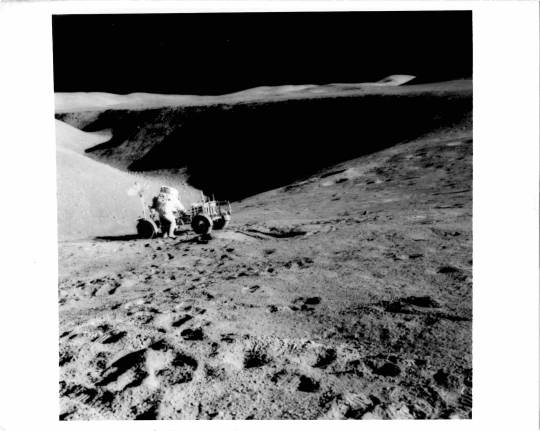
Vintage Nasa Photograph
20.1 x 25.4 cm, Vintage Gelatin silver print
James Irwin, David Scott and the Lunar Rover, Apollo 15, August 1971
#Moon#Nasa#Vintagenasaphotograph#Vintagephoto#Photo#Vintage gelatin silver print#gelatin silver print#Apollo#Apollo 15#Lunar#Lunar Rover#1971#Nasavintagephoto#James Irwin#David Scott#Rover
1 note
·
View note
Photo
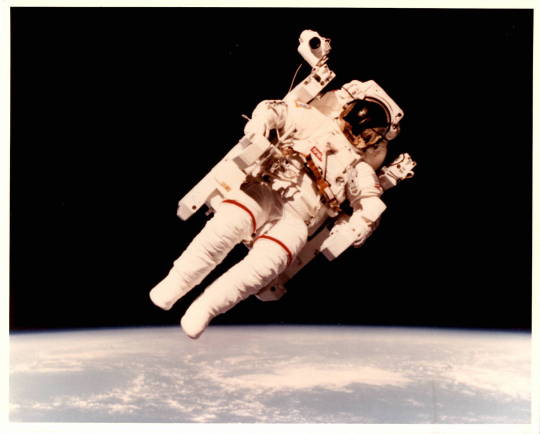
The first ever untethered EVA by Bruce McCandless
Challenger, February 1984
25.4 cm x 20.2 cm, Vintage Chromogenic Print on a Kodak Paper
Space Challenger
On the mission the first untethered Space walks were carried out by McCandless and Stewart, using the manned manneuvering unit.
Original Rare Vintage Nasa Photograph
#Nasa#VintageNasaphotograph#McCandless#EVA#first ever untethered EVA#Spacewalk#Chromogenic print#vintage#manned manneuvering unit#Space#Challenger#Spacecraft
1 note
·
View note
Photo

First Color Picture of the Planet.
25.4 x 20.1 cm, Vintage chromogenic print on Kodak Paper.
Viking 1-54
P-17164 (color) Sol 1
July 26, 1976
PHOTO CAPTION
This color picture of Mars was taken July 21 -- the day following Viking 1's successfull landing on the planet. The local Time on Mars is approximately noon. The view is southeast from the Viking. Orange-red surface materials cover most of the surface, apparently forcming a thin veneer over darker bedrock exposed in patches, as in the lower right. The reddish surface materials may be limonite (hydrated ferric oxide). Such weathering products form on Earth in presence of water and an oxidizing temperature atmosphere.
The sky has a reddish cast, probably due to scattering and reflection from reddish sediment suspended in the lower atmosphere . The scene was scanned three times by the spacecraft's camera 2, through a different color filter each time. To assist in balancing the colors, a second picture was taken of a test chart mounted on the rear of the spacecraft. Color data for the patches were adjusted until the patches were an appropriate color of gray. The same calibration was then used for the entire scene. Another version of this photo (Viking 1-46) with a sky that appeared more pink, gray and blue was shown last week. This interpretation has been modified with further processing.
Very Rare Original Vintage Nasa Photograph Of Mars.
#MARS#planet#Nasa#Vintagenasaphotograph#Vintage#Photo#Space#Viking#Viking1#First color photo#Landscape#Red#Chromogenic print#Original
0 notes
Photo

Original Vintage Nasa Photograph
20.1cm x 25.4 cm, Chromogenic Print on Kodak Paper
S08-70-0149
STS-8 Onboard Scène ... Many hours were spent on STS-8 by its crew-members running tests with the payload flight test article (PFTA) and the remote manipulation system (RMS). The bar-ball chape test device and the arm stand out brilliantly against the darnes of space. The two cameras on the "wrist" and "elbow" of the Canadian-built robot arm provided some closeup scenes of the variegated testing with the PFTA. This frame was exposed with a 35 mm camera aimer through the windows on the flight deck of the Earth-orbiting Space Shuttle Challenger.
Vintage very rare chromogenic print of the National Aeronautics and Space Administration.
#Vintage#VintageNasaPhotograph#Original#NASA#Aeronautics#Space#Spacecraft#STS-8#Challenger#Shuttle#Chromogenic Print#Kodak Paper
0 notes
Photo
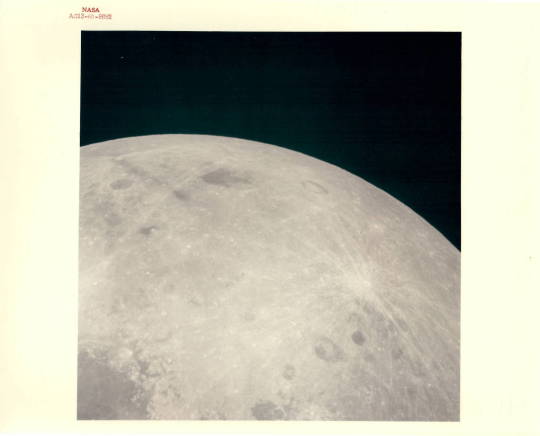
Apollo 13 Bright-Rayed Crater
Vintage Nasa Photograph
20.1 cm x 25.4 cm, Vintage Chromogenic Print on Kodak Paper
NASA No. AS13-60-8682
14 April 1970
This bright-rayed crater on the lunar far-side was photographed from the Apollo 13 spacecraft during its pass around the Moon. This area is northeast of Mare Marginus. The bright-rayed crater is located at about 105 degrees east longitude and 45 degrees north latitude. The crater Joliot-Curie is located between Mare Marginus and the rayed crater. This view is looking generally toward the northeast.
#Moon#Crater#Bright-rayed#VintageNasaPhotograph#Vintage#Photo#Red Serial Number#Nasa#Original#Kodak Paper#Apollo 13
0 notes
Photo
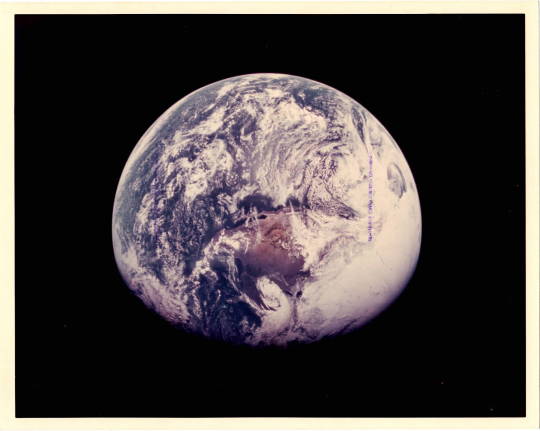
Apollo 16, View of Earth
20.1 cm x 25.4 cm, Vintage Chromogenic Print on Kodak Paper
#Earth#Earthview#Apollo#apollo16#Vintagenasaphotograph#Vintage#Nasa#Photo#Original#chromogenic print#Kodak#goddard
0 notes
Photo
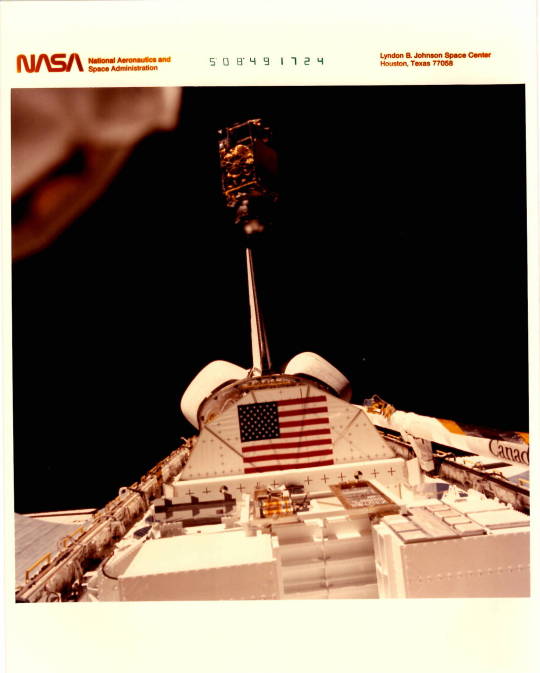
VINTAGE NASA PHOTOGRAPH
CHALLENGER STS-8
S08-49-1724 - STS-008 - Deployment of INSAT/PAM-D satellite
The original finding aid described this as:
Description: Sequence of views in which the Indian National Satellite (INSAT), attached to the Payload Deployment Module (PAM-D), is deployed from the Challenger's payload bay.
Subject Terms: COMMUNICATION SATELLITES PAYLOAD ASSIST MODULE PAYLOAD DELIVERY (STS) SPACE SHUTTLE PAYLOADS STS-8 CHALLENGER (ORBITER)
0 notes
Photo

Taken by a Camera Aboard the Satellite ATS 3
The first color photograph of the full planet Earth, Satellite ATS 3, November 10, 1967.Vintage Chromogenic Print on fiber-based Kodak Paper with "A Kodak Paper" watermark on the verso, unmatted.Image size 19.5 cm x 21.8 cm
Paper size 20.1 cm x 25.4 cm
After the roaming success of the Satellite ATS 1 which transmette the first black and white detailled photographs of the whole Earth with its "spin-can cloud camera", Dr. Verner Suomi developed a color camera for ATS 3, launched in November 1967 and sent into an équatorial geostationary orbi (22,236 miles above Earth) which pas to take one of the most iconic photographs in the history of space exploration. This unprecedented photograph showed North and South America, part of Africa and Europe, as well as the southern part of the Greenland ice cap, and Antarctica covered with cloud.The original NASA caution for the photograph was uncharacteristically poetic: " The photo shows the entire disk of the Earth, a cloud-covered globe in the blackness of space." The photograph was to become a symbol of the counterculture movement as the cover illustration of the 1968 "Whole Earth Catalog". Twenty-four Apollo Astronauts from 1968 to 1972 were the only men to witness their planet as a sphere in space.
ORIGINAL VERY RARE VINTAGE NASA PHOTOGRAPH.
PIECE OF HISTORY.
FIRST COLOR PHOTOGRAPH OF THE FULL PLANET EARTH.
#earth#earthview#VintageNasaPhotograph#NASA#Vintage#Photo#Satellite#ATS3#Original#Rare#ChromogenicPrint
1 note
·
View note